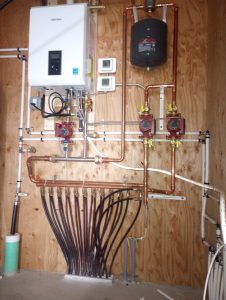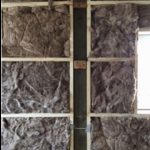Conditioning and Insulating a Shop/House in Spokane (Climate Zone 5B)
My Social Media friend TYLER in SPOKANE writes:
“Hello Mr. Guru, I am planning to build a 48′ x 60′ post frame shop with a 48’x20′ finished living space inside and the remaining to be insulated and climate controlled shop space. I’m planning for 14′ floor to ceiling height in the shop area to accommodate 12′ tall overhead garage doors. I am thinking of doing an 8′ ceiling in the finished space with a framed platform ceiling so I could utilize the space above for storage. My question is how would you go about efficiently heating and cooling this building? I’ve seen that you’re familiar with Spokane Washington so I’m sure you’re aware the range of temperatures in the area. One would think it would be more efficient to climate control the interior finished space on a separate system or zone than the shop area. The shop area would be okay having more tolerance in temperatures but would still need to be controlled. What type of HVAC/insulation solution would work best in your opinion? Thank you”
Radiant floor heat – have shop and living space on their own zones. www.RadiantOutfitters.com can set you up with the right products, done the right way. If you can afford to do so, go with geothermal (https://www.hansenpolebuildings.com/2016/12/modern-post-frame-buildings-geothermal/) as you can use it for both heating and cooling.
 Insulation – Spokane is in Climate Zone 5B. Under slab, you want a well-sealed vapor barrier of at least 6mil (thicker is better and less likely to puncture while placing insulation, etc.). Code requires R-5 under slab insulation, however most people use R-10 under heated slabs. Slab edge insulation is required, but need not extend below slab, if heated.
Insulation – Spokane is in Climate Zone 5B. Under slab, you want a well-sealed vapor barrier of at least 6mil (thicker is better and less likely to puncture while placing insulation, etc.). Code requires R-5 under slab insulation, however most people use R-10 under heated slabs. Slab edge insulation is required, but need not extend below slab, if heated.
Walls – from out to in: Weather Resistant Barrier (housewrap), bookshelf wall girts, R-30 unfaced Rockwool batts (fit perfectly with 2×8 girts), well-sealed 6mil interior vapor barrier.
Ceiling – vent eaves and ridge in proper proportion, order roof steel with an Integral Condensation Control factory applied, raised heel roof trusses to allow for full depth of blow- in R-60 insulation from wall-to-wall.
Tag Archives: unfaced rockwool batts
Retrofitting for an Interior Workshop
Loyal reader LAURI in NORTH BRANCH writes:
“Thank you ahead of time for your generous gift of answering these questions. I love your blog. I have a 40 x 60 pole barn and doing an interior workshop of 25 x 40. Exterior walls (only in workshop area) have no vapor retarder and have R15 in Owens Corning pink board topped with 3/4″ plywood. I put in a tin ceiling (in the workshop area only) with no vapor retarder. I have not insulated the attic area above the workshop yet. It is well ventilated with eave and ridge vents. I put in a 2 x 6 partition wall which will separate the workshop area from uninsulated storage area. I will infrequently be using some form of AC on the hottest MN days and only occasionally use some form of heat (forced air, Mr. Heater or torpedo heater) to heat the workshop. The floors are sealed but without a vapor retarder under the concrete. I’m torn on what to do with the partition wall insulation. Vapor retarder or no Vapor retarder on the shop side? The interior shop wall covering will be 3/4″ plywood and the storage side will be OSB I have on hand. I’m thinking a wool product for minimizing any potential for mold. What insulation should I use for the attic space at truss chord level? I think you lean towards a blown in but can I leave the underside of the roof uninsulated? Vapor barrier or no vapor barrier on interior partition wall? What questions am I not asking that I should be? Thanks again for your wisdom. Nice to feel that someone has our interests at heart. Wish I would have found you guys before I built. Maybe a second one will be in our future where we can pay back the kindness.”
Mike the Pole Barn Guru says:
Thank you for your kind words, they are greatly appreciated.
My goal is to always try to assist people from making crucial mistakes they will regret forever.
 My concerns for your workshop area are going to be ones of moisture – although your slab on grade has been sealed, it has no vapor barrier underneath, so you are probably yet going to have moisture passing through. Heating with either propane or kerosene will be adding even more moisture into this area.
My concerns for your workshop area are going to be ones of moisture – although your slab on grade has been sealed, it has no vapor barrier underneath, so you are probably yet going to have moisture passing through. Heating with either propane or kerosene will be adding even more moisture into this area.
 I would look at design solutions allowing moisture to pass out of your workshop, and not in. For those interior walls, unfaced Rockwool batts, with a housewrap on the cold storage side of studs. Ceiling, if you can find it, use blown granulated Rockwool, as it is unaffected by moisture. Otherwise use Rockwool batts, overlaying layers 90 degrees to each other.
I would look at design solutions allowing moisture to pass out of your workshop, and not in. For those interior walls, unfaced Rockwool batts, with a housewrap on the cold storage side of studs. Ceiling, if you can find it, use blown granulated Rockwool, as it is unaffected by moisture. Otherwise use Rockwool batts, overlaying layers 90 degrees to each other.
If you have no thermal break between roof purlins and roof steel, you are likely to have some condensation challenges, even if well ventilated. Keep a close watch and if you see condensation beginning to form, have two inches of closed cell spray foam applied to the underside of roof steel, otherwise it will rain on you.
Poor Project Planning Makes for Poor Results.
I am feeling WESLEY in DULUTH’s pain as he describes his situation below:
“Hello! I have a question regarding insulation and condensation. The picture shows a cathedral style ceiling with 12 inches of space between the tin and bottom of framing. My plan is to use R-38 fiberglass batts spaced from the tin by one inch. The roof is vented with two foot vented soffits and vented ridge cap. I would install a 10 or 15 mil vapor barrier then ¾ poly sheet foam and drywall. Spray foam is out of my budget so not really an option for me. There is no WRB under the tin due to poor project planning. Do you see this causing condensation issues or is there a better solution? Thanks.”

Mike the Pole Barn Guru:
While you may not like my answer, I always tell it like it is.
Without a thermal break directly between roof steel and framing you will have condensation issues, there are no two ways around it. A WRB (Weather Resistant Barrier) would not have helped your situation, as it would allow moisture to pass through and be trapped between it and your roof steel – likely resulting in premature deterioration of your roofing.
You could do:
(a) Remove roof steel and install something – least expensive being a well-sealed Reflective Radiant Barrier; next up being well-sealed Metal Building Insulation (horrid stuff to work with https://www.hansenpolebuildings.com/2011/11/metal-building-insulation-in-pole-buildings-part-i/ and https://www.hansenpolebuildings.com/2011/11/metal-building-insulation/) or solid sheathing (plywood or OSB) with 30# felt (90# if slope is under 3/12) or a synthetic ice and water shield.
Any of these would solve your condensation issue, however it creates yet another problem – trying to insulate and have an inch of unobstructed air flow from eave to ridge above insulation. Not going to happen.
Or
(b) Have two inches of closed cell spray foam applied to the underside of your roof steel, then fill the balance of cavity with unfaced rockwool batts (https://www.hansenpolebuildings.com/2013/03/roxul-insulation/).
Your idea of using fiberglass batts will result in them getting wet from condensation, losing R value and becoming a home for mold and mildew. While spray foam may be out of your budget, the expense of fixing something done wrong will make it sound cheap.






